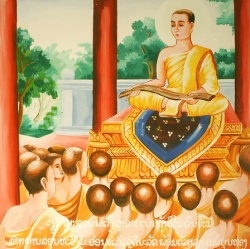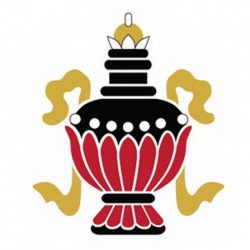Zen school
Zen school
禅宗 (Jpn Zen-shu)
A Buddhist school that teaches that enlightenment is to be gained not through doctrinal studies, but rather through direct perception of one's mind through the practice of meditation.
Known in China as the Ch'an school, its founder is regarded as Bodhidharma (sixth century).
The Zen teaching was summarized in these phrases attributed to Bodhidharma:
"A separate transmission outside the sutras," "independent of words or writing," "directly pointing to the human mind," and "perceiving one's true nature and attaining Buddhahood."
According to this school, the Buddha's supreme enlightenment has been transmitted wordlessly through the ages from mind to mind through the lineage of its patriarchs.
This process began when Shakyamuni Buddha transferred his enlightenment to his disciple Mahaka-shyapa, who is regarded as the first patriarch of Zen.
According to Zen tradition, one day when Shakyamuni was with his disciples on Eagle Peak, he silently picked a flower and held it up in his hand.
At that time only Mahakashyapa grasped the Buddha's meaning, and smiled. Thus, it is said, the Zen teaching was transferred to Mahakashyapa with a smile.
The lineage is said to have passed to the second patriarch, Ananda, the third, Shanavasa, and finally to the twenty-eighth patriarch, Bodhi-dharma,
who brought the "wordless tradition" to China.
Thereafter the teaching of Zen was transmitted to the second Chinese patriarch, Hui-k'o, the third, Seng-ts'an, the fourth, Tao-hsin, the fifth,
Hung-jen, and the sixth, Huineng.
In the time of Huineng (638-713), the school split into the Southern school of Zen, which Huineng led, and the Northern school, led by Shen-hsiu.
The Northern school rapidly declined, and the Southern school became the mainstream of Chinese Zen. Huineng's major disciples were Hsing-ssu, Huai-jang, and Shen-hui.
Liang-chieh, in the lineage of Hsing-ssu, founded the Ts'ao-tung (Jpn Soto) school, and Pen-chi became its second patriarch.
Two other schools, the Yyn-men (Ummon) and Fa-yen (Hogen), were founded in the same lineage by Wen-yen and Wen-i, respectively.
In the lineage of Huai-jang, Ling-yu founded the Kuei-yang (Igyo) school and his disciple Hui-chi further solidified it, while Lin-chi I-hsüan founded the Lin-chi (Rinzai) school.
Among these five schools, the Lin-chi school enjoyed the greatest prosperity, and two branches emerged from it—the Yang-ch'i (Yogi) school, established by Fang-hui, and the Huang-lung (Oryu) school, founded by Hui-nan.
Together, these schools constitute the so-called "five schools and seven schools" of Southern Zen. 833
Zomyo Noted among the first Zen masters in Japan is Dainichi Nonin, who introduced the Zen teaching to that country in the twelfth century; he called his school the Nihon Daruma, or the Japanese Bodhidharma, school.
After his death, his disciples became followers of Dogen (1200-1253), the founder of the Sotoschool of Japanese Zen, and Nonin's school perished.
In 1187 Eisai brought the teachings of the Lin-chi school of Zen from China after his second visit there, and founded the Japanese Rinzai school.
In 1223 Dogen also went to China and brought back the teachings of the Ts'ao-tung school, based upon which he established the Sotoschool. During the Kamakura (1185-1333) and Muromachi (1336-1573) periods, the Zen teachings became popular among the samurai class and prospered greatly. In 1654 the Chinese priest Yin-yüan, known in Japan as Ingen, came to Japan and later founded the Obaku school of Zen.



